Model Test Study on Stability Factors of Expansive Soil Slopes with Different Initial Slope Ratios under Freeze-Thaw Conditions
Abstract
:1. Introduction
2. Experimental Methodology
2.1. Slope Model Test
2.1.1. Slope Model Preparation
2.1.2. Sensor Layout
2.1.3. Experimental Design
2.2. Expansive Soil Nuclear Magnetic Resonance (NMR) Test
3. Results
3.1. Cracks and Pore Volume of Expansive Soil Development
3.2. Moisture Content in the Slope during Freeze-Thaw Cycling
3.3. Soil Pressure in the Slopes during Freeze-Thaw Cycling
3.4. Displacement Changes in the Slope during Freeze-Thaw Cycling
4. Discussion
4.1. Analysis of Cracks during Freeze-Thaw Cycles
4.2. Displacement of the Slope Model in Freeze-Thaw Cycles and Its Microscopic Interpretation
4.3. Engineering Suggestions on Expansive Soil Slope in Seasonal Freezing Area
5. Conclusions
- (1)
- Under freeze-thaw cycling, the slope surface of the expansive soil slope model will be weathered and a large number of cracks will be generated. The main cracks are formed and developed around the slope. The increase in slope ratio will lead to the further development of crack width and depth. The above phenomenon would cause external moisture to enter the inner conditions of the slope, resulting in the risk of landslide;
- (2)
- In the process of freezing and thawing, the moisture in the slope will clearly move upward. During the freezing process, the moisture in the slope moves to the cold source and is fixed by the upper unsaturated expansive soil during the thawing process to increase migration, which eventually leads to the increase in the upper moisture content of the slope model after the freeze-thaw cycle. The slope ratio will affect the rate of heat transfer. The larger the slope ratio is, the faster the temperature transfer rate is, and the greater the value of the change in moisture content in the freeze-thaw cycle of the slope. The change in moisture content increases with the influence of segregation potential;
- (3)
- In the process of freeze-thaw cycling, the skeleton of expansive soil is destroyed, which makes the slope structure looser, and finally leads to a decrease in the contact area of the soil pressure box and a decrease in soil pressure. However, combined with the increase in slope surface gravity caused by moisture migration, it is found that the weight of soil above the most dangerous sliding surface increases and the overturning moment increases. At the same time, the larger the slope ratio is, the greater the increase in the overturning moment of the most dangerous sliding surface;
- (4)
- In the freeze-thaw cycle, the slope tends to develop towards the free face. In the freezing stage, downward creep of the slope occurs with the top falling and the bottom rising, and the increase in slope ratio will affect the variation in displacement. The results of nuclear magnetic resonance (NMR) results that the porosity of the saturated expansive soil decreases gradually in the thawing stage, increases first and then decreases in the freezing stage. The comparison of the above two results shows that the displacement of expansive soil can maintain a certain value after freeze-thaw cycling under the specific saturation of expansive soil.
Author Contributions
Funding
Institutional Review Board Statement
Informed Consent Statement
Data Availability Statement
Acknowledgments
Conflicts of Interest
References
- Jia, Z.G.; Li, F.R.; Li, K. Instability and Failure Mechanism of Slope in the Condition of Extreme Snow Hazard. Appl. Mech. Mater. 2013, 353–356, 208–212. [Google Scholar] [CrossRef]
- Korshunov, A.; Doroshenko, S.P.; Nevzorov, A.L. The Impact of Freezing-thawing Process on Slope Stability of Earth Structure in Cold Climate. Procedia Eng. 2016, 143, 682–688. [Google Scholar] [CrossRef] [Green Version]
- Subramanian, S.S.; Ishikawa, T.; Tokoro, T. Stability assessment approach for soil slopes in seasonal cold regions. Eng. Geol. 2017, 221, 154–169. [Google Scholar] [CrossRef]
- Jones, L.D.; Jefferson, I. Expansive Soils; ICE Publishing: London, UK, 2012; pp. 413–441. [Google Scholar]
- Suits, L.D.; Sheahan, T.; Prakash, K.; Sridharan, A. Free Swell Ratio and Clay Mineralogy of Fine-Grained Soils. Geotech. Test. J. 2004, 27, 220–225. [Google Scholar] [CrossRef]
- Li, T.; Kong, L.; Liu, B. The California Bearing Ratio and Pore Structure Characteristics of Weakly Expansive Soil in Frozen Areas. Appl. Sci. 2020, 10, 7576. [Google Scholar] [CrossRef]
- Luo, J.; Tang, L.; Ling, X.; Geng, L. Experimental and analytical investigation on frost heave characteristics of an unsaturated moderately expansive clay. Cold Reg. Sci. Technol. 2018, 155, 343–353. [Google Scholar] [CrossRef]
- Lu, Y.; Liu, S.; Alonso, E.; Wang, L.; Xu, L.; Li, Z. Volume changes and mechanical degradation of a compacted expansive soil under freeze-thaw cycles. Cold Reg. Sci. Technol. 2019, 157, 206–214. [Google Scholar] [CrossRef]
- Tang, L.; Cong, S.; Geng, L.; Ling, X.; Gan, F. The effect of freeze-thaw cycling on the mechanical properties of expansive soils. Cold Reg. Sci. Technol. 2018, 145, 197–207. [Google Scholar] [CrossRef]
- Yang, Z.; Zhang, L.; Ling, X.; Li, G.; Tu, Z.; Shi, W. Experimental study on the dynamic behavior of expansive soil in slopes under freeze-thaw cycles. Cold Reg. Sci. Technol. 2019, 163, 27–33. [Google Scholar] [CrossRef]
- Guo, Y.; Shan, W. Monitoring and Experiment on the Effect of Freeze-Thaw on Soil Cutting Slope Stability. Procedia Environ. Sci. 2011, 10, 1115–1121. [Google Scholar] [CrossRef] [Green Version]
- Hazirbaba, K.; Zhang, Y.; Hulsey, J.L. Evaluation of temperature and freeze-thaw effects on excess pore pressure generation of fine-grained soils. Soil Dyn. Earthq. Eng. 2011, 31, 372–384. [Google Scholar] [CrossRef]
- Wang, T.; Li, P.; Li, Z.; Hou, J.; Xiao, L.; Ren, Z.; Xu, G.; Yu, K.; Su, Y. The effects of freeze-thaw process on soil water migration in dam and slope farmland on the Loess Plateau, China. Sci. Total Environ. 2019, 666, 721–730. [Google Scholar] [CrossRef] [PubMed]
- Ng, C.W.W.; Zhan, L.T.; Bao, C.G.; Fredlund, D.G.; Gong, B.W. Performance of an unsaturated expansive soil slope subjected to artificial rainfall infiltration. Géotechnique 2003, 53, 143–157. [Google Scholar] [CrossRef]
- Khan, M.S.; Hossain, S.; Ahmed, A.; Faysal, M. Investigation of a shallow slope failure on expansive clay in Texas. Eng. Geol. 2017, 219, 118–129. [Google Scholar] [CrossRef]
- Chen, T.-L.; Zhou, C.; Wang, G.-L.; Liu, E.-L.; Dai, F. Centrifuge Model Test on Unsaturated Expansive Soil Slopes with Cyclic Wetting–Drying and Inundation at the Slope Toe. Int. J. Civ. Eng. 2018, 16, 1341–1360. [Google Scholar] [CrossRef]
- Zhang, C.; Cai, Z.-Y.; Huang, Y.-H.; Chen, H. Laboratory and Centrifuge Model Tests on Influence of Swelling Rock with Drying-Wetting Cycles on Stability of Canal Slope. Adv. Civ. Eng. 2018, 2018, 4785960. [Google Scholar] [CrossRef] [Green Version]
- Silvani, C.; Lucena, L.; Guimarães Tenorio, E.; Filho, H.C.S.; Consoli, N.C. Key Parameter for Swelling Control of Compacted Expansive Fine-Grained Soil-Lime Blends. J. Geotech. Geoenviron. Eng. 2020, 146, 06020012. [Google Scholar] [CrossRef]
- Nowamooz, H.; Masrouri, F. Hydromechanical behaviour of an expansive bentonite/silt mixture in cyclic suction-controlled drying and wetting tests. Eng. Geol. 2008, 101, 154–164. [Google Scholar] [CrossRef]
- Wang, N.; Zhang, W.; Gu, X.; Zeng, Y. Model Test on Inundation Swelling Deformation of Expansive Soil Foundation. J. Highw. Transp. Res. Dev. (Engl. Ed.) 2008, 3, 72–76. [Google Scholar] [CrossRef]
- Cheng, Z.L.; Ding, J.H.; Rao, X.B.; Cheng, Y.; Xu, H. Physical Model Tests of Expansive Soil Slope; Geo-Congress: San Diego, CA, USA, 2013. [Google Scholar] [CrossRef]
- Zhang, M.; Zhang, X.; Lu, J.; Pei, W.; Wang, C. Analysis of volumetric unfrozen water contents in freezing soils. Exp. Heat Transf. 2018, 32, 426–438. [Google Scholar] [CrossRef]
- Khattab, S.A.; Al-Mukhtar, M.; Fleureau, J.-M. Long-Term Stability Characteristics of a Lime-Treated Plastic Soil. J. Mater. Civ. Eng. 2007, 19, 358–366. [Google Scholar] [CrossRef]
- Lu, Y.; Liu, S.; Weng, L.; Wang, L.; Li, Z.; Xu, L. Fractal analysis of cracking in a clayey soil under freeze-thaw cycles. Eng. Geol. 2016, 208, 93–99. [Google Scholar] [CrossRef]
- Wang, Y.-X.; Guo, P.; Ren, W.-X.; Yuan, B.-X.; Yuan, H.-P.; Zhao, Y.; Shan, S.-B.; Cao, P. Laboratory Investigation on Strength Characteristics of Expansive Soil Treated with Jute Fiber Reinforcement. Int. J. Géoméch. 2017, 17, 04017101. [Google Scholar] [CrossRef]
- Li, Y.-X.; Yang, X.-L. Stability analysis of crack slope considering nonlinearity and water pressure. KSCE J. Civ. Eng. 2015, 20, 2289–2296. [Google Scholar] [CrossRef]
- Wu, L.; Huang, R.; Xu, Q.; Zhang, L.; Li, H.L. Analysis of physical testing of rainfall-induced soil slope failures. Environ. Earth Sci. 2015, 73, 8519–8531. [Google Scholar] [CrossRef]
- ASTM D698-12e2. Standard Test Methods for Laboratory Compaction Characteristics of Soil Using Standard Effort (12,400 ft–lbf/ft3 (600 kN–m/m3)); ASTM International: West Conshohocken, PA, USA, 2012. [Google Scholar] [CrossRef]
- Teng, J.; Shan, F.; He, Z.; Zhang, S.; Zhao, G.; Sheng, D. Experimental study of ice accumulation in unsaturated clean sand. Géotechnique 2019, 69, 1–32. [Google Scholar] [CrossRef]
- Xu, X.; Wang, B.; Fan, C.; Zhang, W. Strength and deformation characteristics of silty clay under frozen and unfrozen states. Cold Reg. Sci. Technol. 2020, 172, 102982. [Google Scholar] [CrossRef]
- Azañón, J.M.; Azor, A.; Yesares, J.; Tsige, M.; Mateos, R.M.; Nieto, F.; Delgado, J.; Chicano, M.L.; Martín, W.; Rodríguez-Fernández, J. Regional-scale high-plasticity clay-bearing formation as controlling factor on landslides in Southeast Spain. Geomorphology 2010, 120, 26–37. [Google Scholar] [CrossRef]
- ASTM D854-14. Standard Test Methods for Specific Gravity of Soil Solids by Water Pycnometer; ASTM International: West Conshohocken, PA, USA, 2014. [Google Scholar] [CrossRef]
- ASTM D2216-19. Test Methods for Laboratory Determination of Water (Moisture) Content of Soil and Rock by Mass; ASTM International: West Conshohocken, PA, USA, 2019. [Google Scholar] [CrossRef]
- ASTM D4318-17e1. Standard Test Methods for Liquid Limit, Plastic Limit, and Plasticity Index of Soils; ASTM International: West Conshohocken, PA, USA, 2017. [Google Scholar] [CrossRef]
- Xu, L.; Xue, Y.; Lu, Y.; Song, Y.J.; Zhang, Y.Z.; Kong, W.Y. Test of freeze- thaw cycle of expansive soil under condition of different freezing temperatures. J. Water Resour. Water Eng. 2016, 27, 189–1939. (In Chinese) [Google Scholar] [CrossRef]
- Qin, Z.; Lai, Y.; Tian, Y.; Zhang, M. Stability behavior of a reservoir soil bank slope under freeze-thaw cycles in cold regions. Cold Reg. Sci. Technol. 2021, 181, 103181. [Google Scholar] [CrossRef]
- Chernyshov, C.H. Water Movement in Fracture Network; Geological Publishing House: Beijing, China, 1987. (In Chinese) [Google Scholar]
- Miller, R.D. Freezing and heaving of saturated and unsaturated soils. Highw. Res. Rec. 1972, 393, 1–11. Available online: https://trid.trb.org/view/126419 (accessed on 15 July 2021).
- Konrad, J.-M.; Morgenstern, N.R. A mechanistic theory of ice lens formation in fine-grained soils. Can. Geotech. J. 1980, 17, 473–486. [Google Scholar] [CrossRef]
- Takashi, T.; Ohrai, T.; Yamamoto, H.; Okamoto, J. Upper Limit of Heaving Pressure Derived by Pore-Water Pressure Measurements of Partially Frozen Soil. Fundam. Discret. Elem. Methods Rock Eng.—Theory Appl. 1982, 28, 245–257. [Google Scholar] [CrossRef]
- Wang, D.; Yang, C.; Cheng, G.; Ma, W.; Zhang, L. Experimental Study on Pore Water Pressure and Microstructures of Silty Clay Under Freeze-Thaw Cycles. Lect. Notes Civ. Eng. 2020, 2, 239–254. [Google Scholar] [CrossRef]
- Tang, L.Y.; Yang, D.; Liu, L.; Jin, L.; Yang, L.; Li, G. Effect mechanism of unfrozen water on the frozen soil-structure interface during the freezing-thawing process. Geomech. Geoeng. 2020, 22, 245–254. [Google Scholar] [CrossRef]
- Hamilton, A.B. Freezing Shrinkage in Compacted Clays. Can. Geotech. J. 1966, 3, 1–17. [Google Scholar] [CrossRef]
- Fleureau, J.-M.; Kheirbek-Saoud, S.; Soemitro, R.; Taibi, S. Behavior of clayey soils on drying–wetting paths. Can. Geotech. J. 1993, 30, 287–296. [Google Scholar] [CrossRef]
- Amarasiri, A.L.; Kodikara, J.K.; Costa, S. Numerical modelling of desiccation cracking. Int. J. Numer. Anal. Methods Géoméch. 2011, 35, 82–96. [Google Scholar] [CrossRef]
- Shi, B.-X.; Chen, S.-S.; Han, H.-Q.; Zheng, C.-F. Expansive Soil Crack Depth under Cumulative Damage. Sci. World J. 2014, 2014, 498437. [Google Scholar] [CrossRef]
- Li, J.; Wang, F.; Yi, F.; Wu, F.; Liu, J.; Lin, Z. Effect of Freeze-Thaw Cycles on Triaxial Strength Property Damage to Cement Improved Aeolian Sand (CIAS). Materials 2019, 12, 2801. [Google Scholar] [CrossRef] [Green Version]





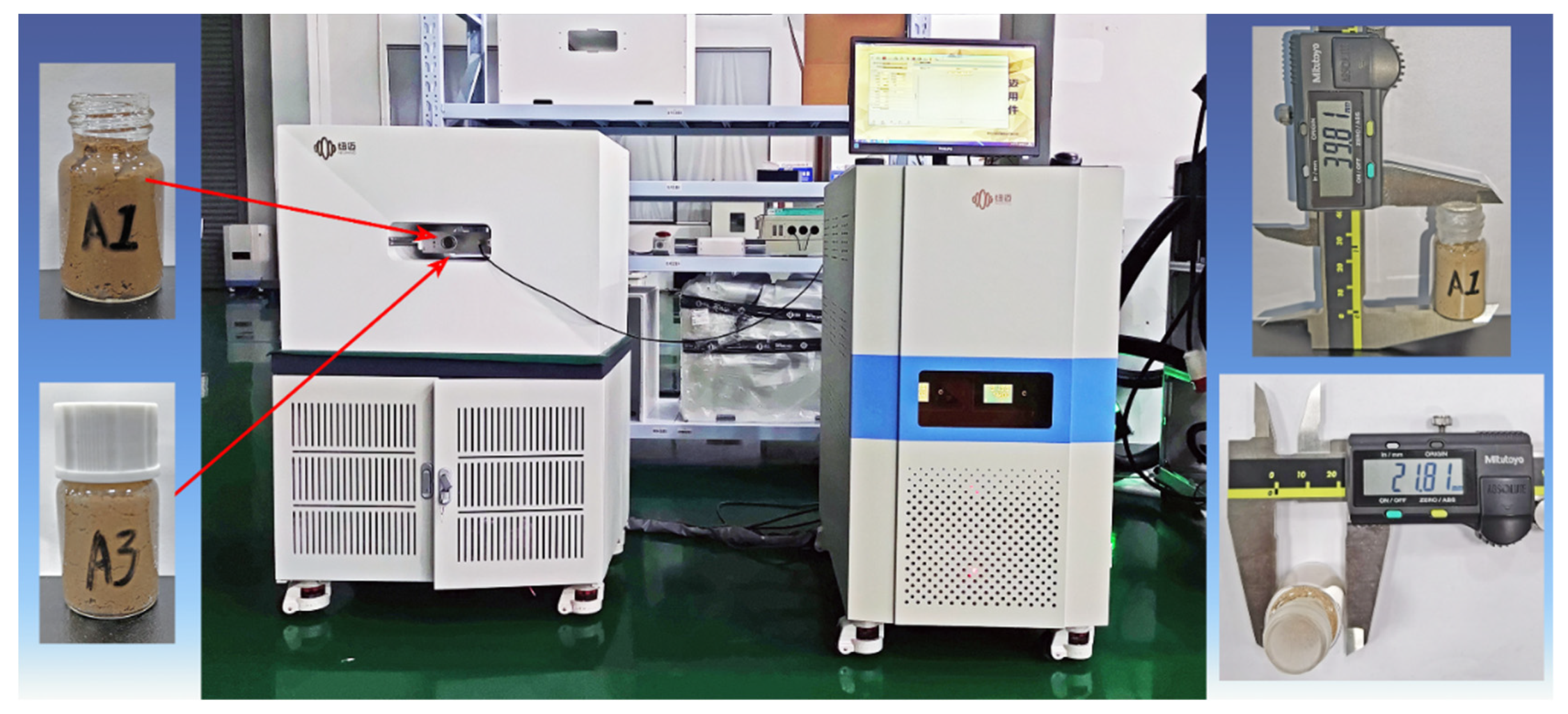
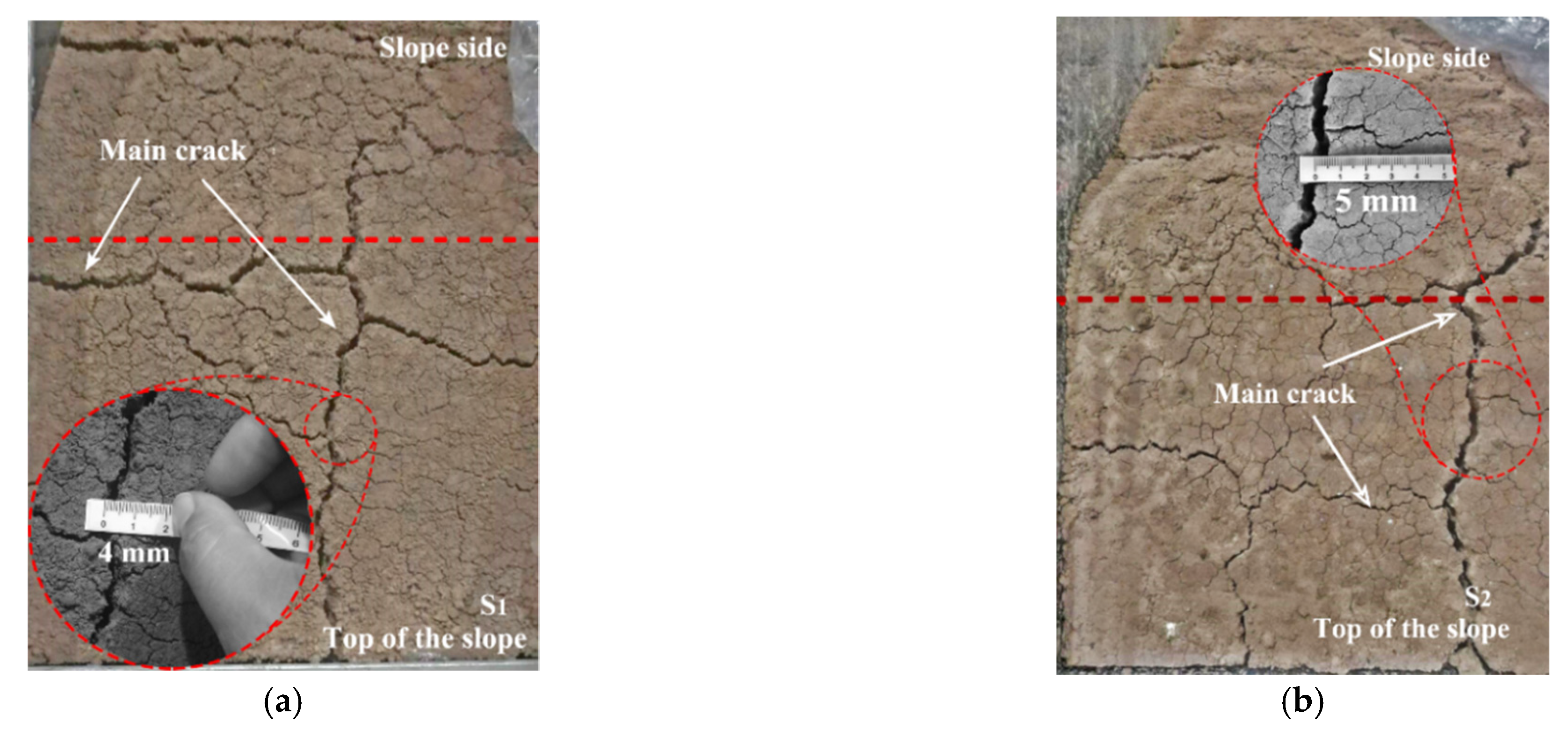






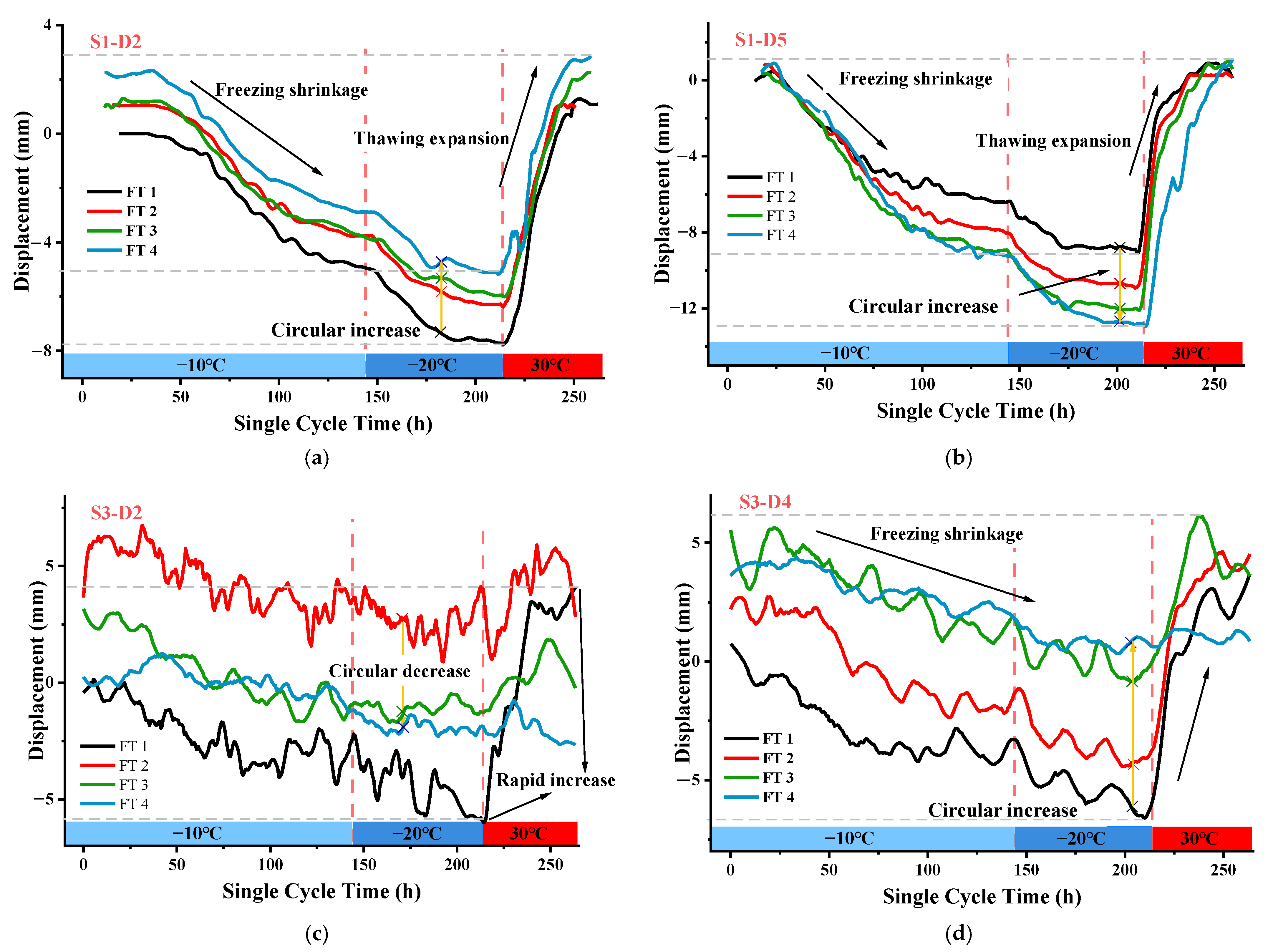

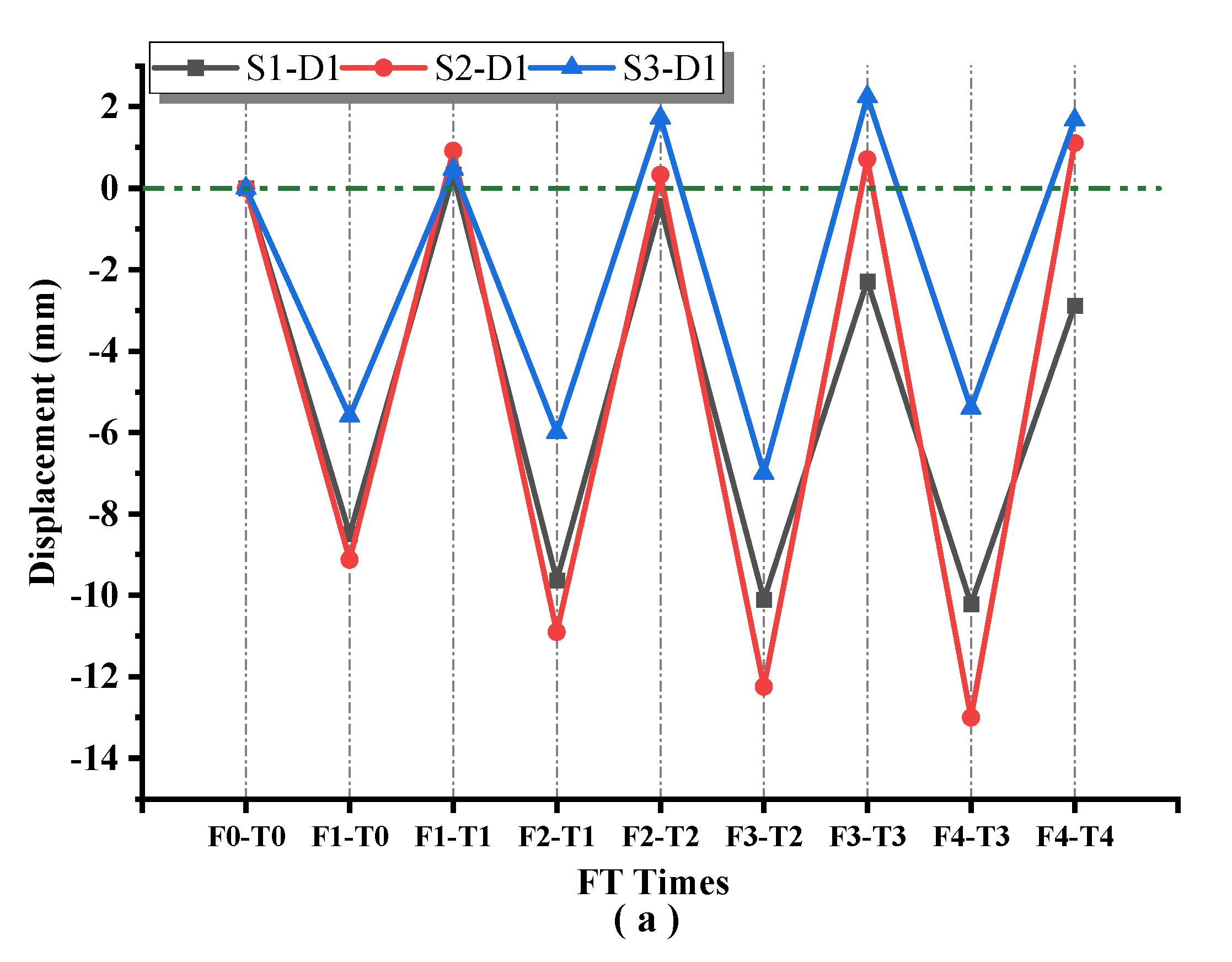
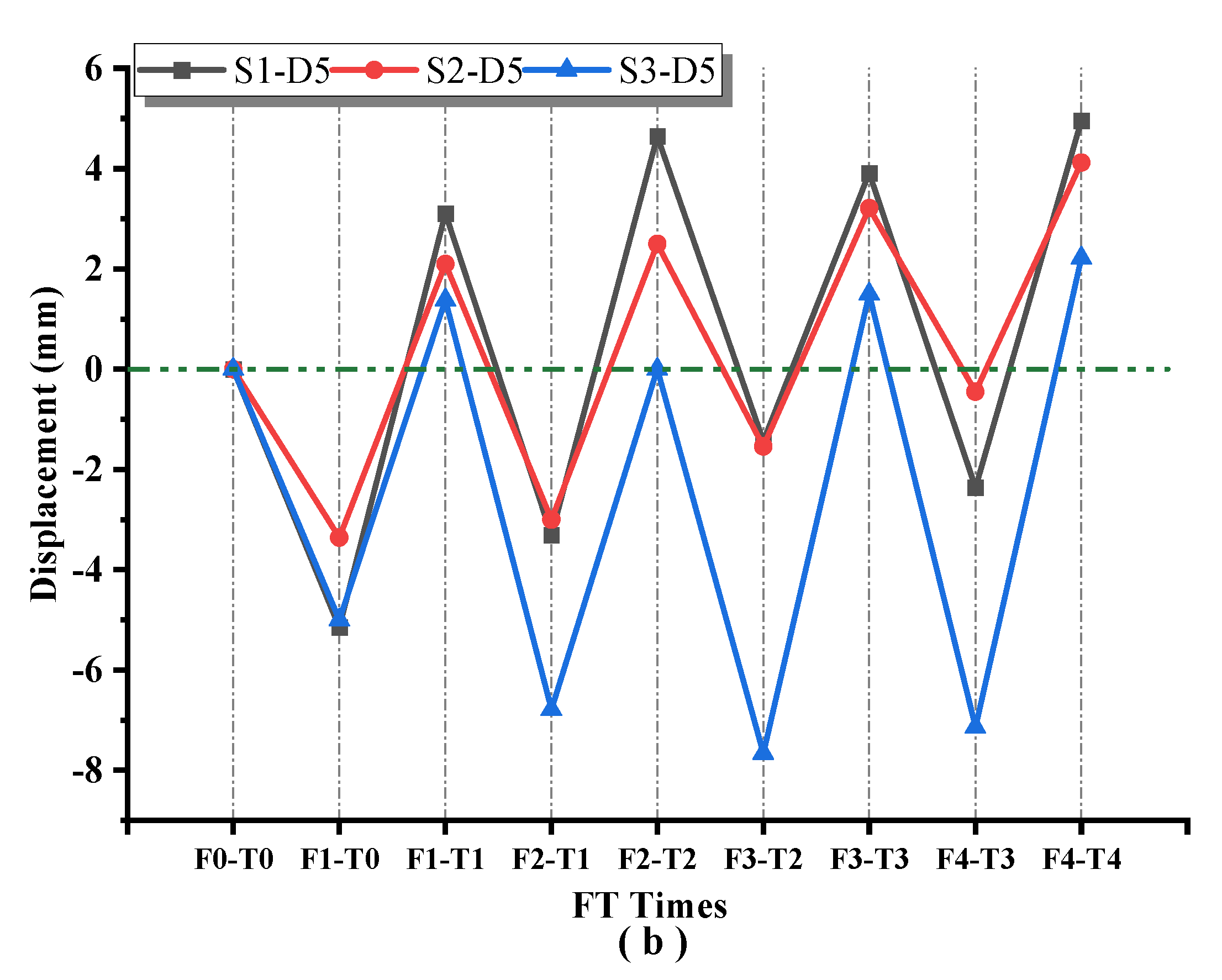
Publisher’s Note: MDPI stays neutral with regard to jurisdictional claims in published maps and institutional affiliations. |
© 2021 by the authors. Licensee MDPI, Basel, Switzerland. This article is an open access article distributed under the terms and conditions of the Creative Commons Attribution (CC BY) license (https://creativecommons.org/licenses/by/4.0/).
Share and Cite
Yang, Z.; Lv, J.; Shi, W.; Zhang, Q.; Lu, Z.; Zhang, Y.; Ling, X. Model Test Study on Stability Factors of Expansive Soil Slopes with Different Initial Slope Ratios under Freeze-Thaw Conditions. Appl. Sci. 2021, 11, 8480. https://doi.org/10.3390/app11188480
Yang Z, Lv J, Shi W, Zhang Q, Lu Z, Zhang Y, Ling X. Model Test Study on Stability Factors of Expansive Soil Slopes with Different Initial Slope Ratios under Freeze-Thaw Conditions. Applied Sciences. 2021; 11(18):8480. https://doi.org/10.3390/app11188480
Chicago/Turabian StyleYang, Zhongnian, Jianhang Lv, Wei Shi, Qi Zhang, Zhaochi Lu, Yingying Zhang, and Xianzhang Ling. 2021. "Model Test Study on Stability Factors of Expansive Soil Slopes with Different Initial Slope Ratios under Freeze-Thaw Conditions" Applied Sciences 11, no. 18: 8480. https://doi.org/10.3390/app11188480
APA StyleYang, Z., Lv, J., Shi, W., Zhang, Q., Lu, Z., Zhang, Y., & Ling, X. (2021). Model Test Study on Stability Factors of Expansive Soil Slopes with Different Initial Slope Ratios under Freeze-Thaw Conditions. Applied Sciences, 11(18), 8480. https://doi.org/10.3390/app11188480






